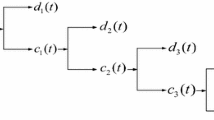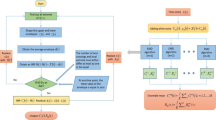Abstract
In this paper, a hybrid approach consisting of pigeon-inspired optimization (PIO) and extreme learning machine (ELM) based on wavelet packet analysis (WPA) is presented for predicting bulk commodity futures prices. Firstly, WPA is applied to decompose the original futures prices into a set of lower-frequency subseries. Secondly, the PIO algorithm is used to optimize the parameters of ELM and then the optimized ELM is utilized to forecast the subseries. Finally, we adopt the hybrid method to calculate the final forecasting outcomes of futures prices. In order to further test the predictive ability of the hybrid forecasting model on bulk commodity futures prices, we use the prices of West Texas Intermediate crude oil futures and Chicago Board of Trade soybean futures to make one-step, two-step and four-step ahead predictions. In comparison with complete ensemble empirical mode decomposition with adaptive noise, empirical mode decomposition and singular spectrum analysis, WPA is the most suitable for decomposing bulk commodity futures prices. The experimental outcomes show that the hybrid WPA-PIO-ELM model has better performance on horizontal precision, directional precision and robustness.
Similar content being viewed by others
References
Chi G T, Li Z J. Forecast model of stock index futures prices based on small sample. ICIC Express Lett Part B Appl Int J Res Surv, 2014, 5: 657–662
Wang C Y. Forecast on price of agricultural futures in China based on ARIMA model. Asian Agr Res, 2016, 8: 9–12
Darekar A, Reddy A. Predicting market price of soybean in major india studies through ARIMA model. Soc Sci Electron Publishing, 2017, 30: 73–76
Xu W C, Zhou H B, Cheng N, et al. Internet of vehicles in big data era. IEEE/CAA J Autom Sin, 2018, 5: 19–35
Mazouchi M, Naghibi-Sistani M B, Sani S K H. A novel distributed optimal adaptive control algorithm for nonlinear multi-agent differential graphical games. IEEE/CAA J Autom Sin, 2018, 5: 331–341
Zhang Y H, Shen X, Shen T L. A survey on online learning and optimization for spark advance control of SI engines. Sci China Inf Sci, 2018, 61: 070201
Li H T, Zhao G D, Meng M, et al. A survey on applications of semi-tensor product method in engineering. Sci China Inf Sci, 2018, 61: 010202
Baruník J, Malinská B. Forecasting the term structure of crude oil futures prices with neural networks. Appl Energy, 2016, 164: 366–379
Hu J W S, Hu Y C, Lin R R W. Applying neural networks to prices prediction of crude oil futures. Math Probl Eng, 2012, 2012: 1–12
Zhang X M, Han Q L, Zeng Z. Hierarchical type stability criteria for delayed neural networks via canonical bessellegendre inequalities. IEEE Trans Cybern, 2018, 48: 1660–1671
Zhang Y, He J, Yin T F. Research on petroleum price prediction based on SVM. Comput Simul, 2012, 29: 375–377
Zhang J L, Zhang Y J, Zhang L. A novel hybrid method for crude oil price forecasting. Energy Econ, 2015, 49: 649–659
Das S P, Padhy S. A novel hybrid model using teaching-learning-based optimization and a support vector machine for commodity futures index forecasting. Int J Mach Learn Cyber, 2018, 9: 97–111
Ela A A A E, Abido M A, Spea S R. Differential evolution algorithm for optimal reactive power dispatch. Electric Power Syst Res, 2011, 81: 458–464
Zhang D F, Duan H B, Yang Y J. Active disturbance rejection control for small unmanned helicopters via Levy flight-based pigeon-inspired optimization. Aircraft Eng Aerospace Tech, 2017, 89: 946–952
Chen H H, Chen M, Chiu C C. The integration of artificial neural networks and text mining to forecast gold futures prices. Commun Stat-Simul Comput, 2016, 45: 1213–1225
Dou R, Duan H B. Pigeon inspired optimization approach to model prediction control for unmanned air vehicles. Aircraft Eng Aerospace Tech, 2016, 88: 108–116
Pang B, Liu M, Zhang X, et al. A novel approach framework based on statistics for reconstruction and heartrate estimation from PPG with heavy motion artifacts. Sci China Inf Sci, 2018, 61: 022312
Sun S L, Wang S Y, Zhang G W, et al. A decomposition-clustering-ensemble learning approach for solar radiation forecasting. Sol Energy, 2018, 163: 189–199
Liu H, Mi X W, Li Y F. Comparison of two new intelligent wind speed forecasting approaches based on wavelet packet decomposition, complete ensemble empirical mode decomposition with adaptive noise and artificial neural networks. Energy Convers Manag, 2018, 155: 188–200
Jiang F, He J Q, Zeng Z G, et al. A decomposition-optimization-ensemble learning approach for electricity price forecasting (in Chinese). Sci Sin Inform, 2018, 48: 1300–1315
Wang D Y, Yue C Q, Wei S, et al. Performance analysis of four decomposition-ensemble models for one-day-ahead agricultural commodity futures price forecasting. Algorithms, 2017, 10: 108
Wang Y, Qi C, Li M F. Prediction of commodity prices based on SSA-ELM. Syst Eng-Theory Pract, 2017, 37: 2004–2014
Lu H F. Price forecasting of stock index futures based on a new hybrid EMD-RBF neural network model. Agro Food Ind Hi Tech, 2017, 28: 1744–1747
Wang J, Li X. A combined neural network model for commodity price forecasting with SSA. Soft Comput, 2018, 22: 5323–5333
Huang G B, Zhu Q Y, Siew C K. Extreme learning machine: theory and applications. Neurocomputing, 2006, 70: 489–501
Duan H B, Qiao P X. Pigeon-inspired optimization: a new swarm intelligence optimizer for air robot path planning. Int J Intel Comput Cyber, 2014, 7: 24–37
Diebold F X, Mariano R S. Comparing predictive accuracy. J Business Economic Stat, 2002, 20: 134–144
Pesaran M H, Timmermann A. A simple nonparametric test of predictive performance. J Business Economic Stat, 1992, 10: 461–465
Helske J, Luukko P. Ensemble empirical mode decomposition (EEMD) and its complete variant (CEEMDAN). Int J Public Health, 2016, 60: 1–9
Author information
Authors and Affiliations
Corresponding authors
Rights and permissions
About this article
Cite this article
Jiang, F., He, J. & Zeng, Z. Pigeon-inspired optimization and extreme learning machine via wavelet packet analysis for predicting bulk commodity futures prices. Sci. China Inf. Sci. 62, 70204 (2019). https://doi.org/10.1007/s11432-018-9714-5
Received:
Accepted:
Published:
DOI: https://doi.org/10.1007/s11432-018-9714-5




